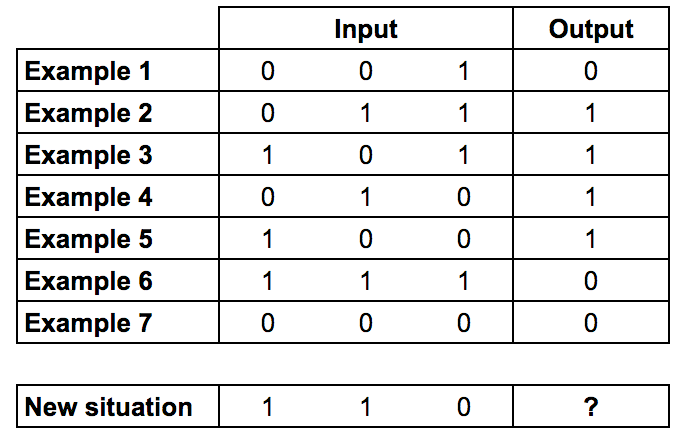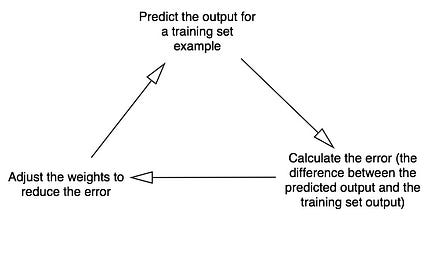理解神經網路,從簡單的例子開始(2)使用python建立多層神經網路
這篇文章將講解如何使用python建立多層神經網路。在閱讀這篇文章之前,建議先閱讀上一篇文章:理解神經網路,從簡單的例子開始。講解的是單層的神經網路。如果你已經閱讀了上一篇文章,你會發現這篇文章的程式碼和上一篇基本相同,理解起來也相對容易。
上一篇文章使用了9行程式碼編寫一個單層的神經網路。而現在,問題變得更加複雜了。下面是訓練輸入資料和訓練輸出資料,如果輸入資料是[1,1,0],最後的結果是什麼呢?

從上面的輸入輸出資料可以找出規律:第一和第二列的值“異或”之後得到output的值,而第三列沒有關係。所謂的異或,就是相同為0,相異為1.
所以,當輸入資料為[1,1,0]時,結果為0。
但是,這個在單層網路節點中是很難實現的,因為input和output之間沒有一對一的對應關係。所以,可以考慮使用多層的神經網路,或者說增加一個隱藏層,叫layer1,它能夠處理input的合併問題。
從圖中可以看出,第1層的輸出進入第2層。現在神經網路能夠處理第一層的輸出資料和第二層(也就是最終輸出的資料集)之間的關係。隨著神經網路學習,它將通過調整兩層的權重來放大這些相關性。
實際上,影象識別和這個很相似。比如下面圖片中,一個畫素和蘋果沒有直接的關係,但是許多畫素組合在一起就能夠構成一個蘋果的樣子,也就產生了關係。

這裡通過增加更多層神經來處理“組合”問題,便是所謂的深度學習了。下面是多層神經網路的python程式碼。解釋會在程式碼註釋中和程式碼後面。
from numpy import exp, array, random, dot
class NeuronLayer 
上圖是深度學習的計算週期
和上篇部落格中的單層神經網路相比,這裡是多層,也就是增加了隱藏層。當神經網路計算第二層的error誤差值的時候,會把這個error向後面一層也即是第一次傳播,從而計算並調整第一層節點的權值。也就是,第一層的error誤差值是從上一層也即是第二層所傳播回來的值中計算得到的,這樣就能夠知道第一層對第二層的誤差有多大的貢獻。
執行上面的程式碼,會得到下面所示的結果。
Stage 1) Random starting synaptic weights:
Layer 1 (4 neurons, each with 3 inputs):
[[-0.16595599 0.44064899 -0.99977125 -0.39533485]
[-0.70648822 -0.81532281 -0.62747958 -0.30887855]
[-0.20646505 0.07763347 -0.16161097 0.370439 ]]
Layer 2 (1 neuron, with 4 inputs):
[[-0.5910955 ]
[ 0.75623487]
[-0.94522481]
[ 0.34093502]]
Stage 2) New synaptic weights after training:
Layer 1 (4 neurons, each with 3 inputs):
[[ 0.3122465 4.57704063 -6.15329916 -8.75834924]
[ 0.19676933 -8.74975548 -6.1638187 4.40720501]
[-0.03327074 -0.58272995 0.08319184 -0.39787635]]
Layer 2 (1 neuron, with 4 inputs):
[[ -8.18850925]
[ 10.13210706]
[-21.33532796]
[ 9.90935111]]
Stage 3) Considering a new situation [1, 1, 0] -> ?:
[ 0.0078876]這篇文章是本人根據這篇部落格寫的。一定程度上算是在做翻譯的工作。本人特別推薦該原始碼的風格,一看就知道這是程式設計經驗豐富之人才能寫出來的程式碼,清晰明瞭,看起來特別舒服。
結束! 轉載請標明出處,感謝!
